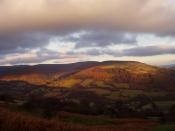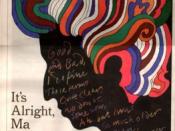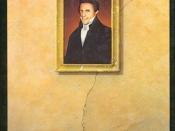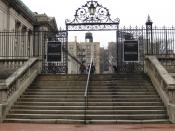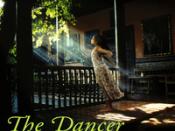Nicholas Shakespeare is a novelist who grew up in the Far East before settling in Tasmania. His novels are The Vision of Elena Silves (1989,winner of the Somerset Maugham Award), The High Flyer (1993,nominated as one of GrantaÃÂs Best of Young British Novelists of 1993), and The Dancer Upstairs (1995,named American Library Association Best Novel of 1997 after its U.S. publication).
Bruce ChatwinÃÂs What Am I Doing Here (1989) and Anatomy of Restlessness (1996) might well serve as twin epitaphs for his life. As a wanderer and a seeker, he roamed the world discovering its peoples, history, geography, stories, and, ultimately, himself. Nicholas ShakespeareÃÂs biography suggests that in his writing Chatwin found the world, but only at his lifeÃÂs end did he find himself.
Charles Bruce Chatwin was born May 13, 1940, near Sheffield, England, to Charles and Margharita (née Turnell), both from middle-class families. Charles served in the Royal Navy, and Bruce spent most of the war living with his grandparents.
He saw little of his father until the military was demobilized. The Milwards, his grandmotherÃÂs family, were world travelers and left the detritus from their wanderings in a Schatzkammer, a cabinet of wonders. Bruce insisted that these treasures first inspired his interest in travel.
After the war Charles resumed his legal practice, and the family, enlarged by the birth of BruceÃÂs brother Hugh, settled in BrownÃÂs Green House south of Birmingham, where Bruce was enrolled at Innisfree House. Later he claimed he was hopeless at school. In September, 1953, Bruce entered Malborough College, where, despite his disclaimer, he did well in English and history. He also excelled at dramatics and began his lifelong passion for collecting. His first real trip abroad came when he spent a summer in Sweden. Being away from England and family proved to have a lasting impact. Further trips to the continent during his school years increased the fascination with travel that consumed him throughout his life.
Although he prepared for Oxford, the cessation of national service overcrowded the university, delaying his entrance. His father also lacked the finances. So Bruce went to London to work at SothebyÃÂs, the auction house, which provided the training for his ÃÂeyeàand the beginnings of his writing career. A protégé of the firmÃÂs director, Peter Wilson, Bruce rose quickly in the ranks, first to Antiquities and then to Impressionist Paintings, becoming head of both departments. SothebyÃÂs encouraged BruceÃÂs wanderlust, and he traveled extensively, searching for objects to auction. His advancing salary also allowed him to expand his collecting; more objects, and costlier ones, soon passed through his hands. Living in London also broadened his sex life with both women and men.
Then Bruce met Elizabeth Chandler, WilsonÃÂs secretary. She came from a distinguished, rich, and eccentric family descended from the Laughlin steel fortune. Her fatherÃÂs mother was a friend of Henry James and his father was the grandson of John Jacob Astor. When Bruce and Elizabeth married in 1965, he felt as though he had joined the American aristocracy. However, marriage did not curb BruceÃÂs wanderings, and over the years their lives were largely spent apart, with Elizabeth living at their home, Holwell Farm, and Bruce dropping in at odd periods.
In April, 1966, Bruce became a second-tier partner at SothebyÃÂs, and it was widely believed that he would eventually rise to head the firm. That same summer he abruptly quit, citing numerous conflicts with Wilson and the art-collecting world. He left to study archaeology at Edinburgh University. Once again he proved a desultory student, working hard when he wanted to but largely neglecting his classes. He declared that sound scholarship was a piece of baggage too heavy for someone who was in a hurry and traveled light. In the spring of 1969 he simply dropped out of the program. Henceforth, Bruce Chatwin would spend his life as a writer and a traveler.
His first book assignment was for a study of nomads. It took Chatwin fourteen years to write. In the meantime he began writing for Vogue and contributing to other periodicals. In 1972 he was hired as an art consultant for the Sunday Times magazine, and later to write essays on subjects of his own choosing. He became the protégé of Francis Wyndham, the senior editor, who encouraged ChatwinÃÂs travels and ruthlessly edited his articles. In December, 1974, Wyndham received a note from Chatwin announcing that he was going to South America.
As a result of the trip, Chatwin wrote his first book, In Patagonia (1977), which launched him into the world of letters and established his career. The scrap of sloth skin in his grandmotherÃÂs cabinet sent by the adventurer Charles Milward provided the impetus. The search for Milward, his relative, drew Chatwin to Patagonia. He described the country as the ultimate symbol of human restlessness, and in writing In Patagonia he revisited the central theme from the nomad book: the journey as metaphor. He also discovered his own calling, not as a travel writer but as a traveling writer, one who wandered the globe looking for the exotic, the unusual, and, ultimately, for himself.
In Patagonia was enthusiastically reviewed and became a cult classic, inspiring pilgrims to wander the routes Chatwin described. Having proven to himself and to his publisher that he could finish a book, he began his next, The Viceroy of Ouidah (1980). Since the criticism of his first book questioned his creative use of the facts, he wrote the next as fiction, albeit fiction informed by history and travel. The bookÃÂs focus is on a Brazilian slave trader who became viceroy in the West African kingdom of Ouidah. As he had done before, Chatwin kept on the move during the bookÃÂs conception and writing. He seemed unable to work at home, a place from which he was becoming increasingly disconnected. Friends of both Elizabeth and Bruce marveled at her tolerance of his absences, of his many lovers, of their life apart.
The book was well received and sold better than In Patagonia, the American edition doing especially well after Bruce won the Hawthornden Prize. It also received awards from The New York Times Book Review and the American Academy of Arts and Letters. Chatwin reveled in the attention and was taken up by the glitterati in Great Britain and the United States, but he never stopped wandering. Nor did he slow his need for conquests of both sexes, and his unwise sexual practices eventually ended his life prematurely when he succumbed to AIDS.
His next book, On the Black Hill (1982), was also a novel. It was this work, Shakespeare notes, that allowed Chatwin to explore what it might have been like if he had never left home. It is the story of two Welsh brothers, twins, who live on an isolated farm and have never been apart or traveled far from their family homestead. On the Black Hill is about a very different kind of place from the ones in the previous books, a place peopled not by wanderers but by the settled. It was written quickly and easily, and ChatwinÃÂs vocation as an author was assured by its publication. His personal life, though, was less assured. Elizabeth finally reached the end of her patience and ejected him from Holwell Farm, and, even though they met periodically, they reconciled only when he returned to her nursing care during the final stages of his illness.
In 1987 The Songlines was published. It contained the germ of ChatwinÃÂs thesis from his book on nomads, and it brought his writing life full circle. The setting was Australia, and the book examined the nomadic Aborigines and the ÃÂsonglinesÃÂ of their belief systems. Bruce felt that humans were genetically programmed to wander, that settlements were an anomaly that encouraged the worst in people and stifled the spiritual nature of the species. In The Songlines, Chatwin set out to illustrate this idea.
By the time he began work on The Songlines, Chatwin was experiencing the onset of his disease, which, to the end, he told friends and the public was caused by a mysterious fungus he had picked up on his travels abroad. Again he wandered from place to place while he was writing, and at Kardamyli in the Greek Peloponnesus he discovered the tiny, ruined Byzantine church of St. Nicholas in Chora, where his ashes would be buried a little over three years later.
The Songlines was dedicated to Elizabeth, and it transformed Chatwin from a cult writer to a best-selling author and made him famous. He was feted by the press, his publisher, and the public. Critics described him as a literary T. E. Lawrence, though they also fretted over the proper genre of the book. However, his readers avidly supported it. Although by now often quite ill, he carried out his publicity tour with seeming relish.
Chatwin wrote his last book, Utz (1988), in the company of Elizabeth in the South of France. It is a short novel about a compulsive collector of fine china living in Prague. It was short-listed for the Booker Prize, but it did not win. If The Songlines concluded ChatwinÃÂs interest in nomads, Utz rounded out his fascination with collecting. By the time of its release he was in the last stages of AIDS, increasingly dependent on Elizabeth and a battery of doctors at the Churchill Hospital in Oxford. He spent his final days editing What Am I Doing Here, a collection of his journalistic pieces, and he also began a furious spree of buying, using his increasing royalties to assemble a collection of rarities that would be a monument both to himself and to Elizabeth. It never materialized.
Dying of a disease about which little was then known and to which there was a stigma attached, Chatwin refused to admit the true nature of his illness, much to the consternation of those who wanted to publicize it. He even kept the knowledge of it from his family until the last months of his life. His illness, however, changed him. Friends remarked that as he grew sicker, he grew more loving and open, as if finally he had rid himself of the need for the protective mask behind which he had lived his life. His coldness and distance faded to reveal a warmth he had hidden.
In characteristic fashion, Bruce Chatwin died abroad, in the South of France, on January 17, 1989. His remains were cremated at a nondenominational chapel near Nice, with a Greek Orthodox priest officiating, and a private memorial was held at the Greek Cathedral of Santa Sophia in Bayswater. The next day Elizabeth flew to Greece, where his ashes, in a small oak casket, were buried in an unmarked grave near the church of St. Nicholas.
Since his death Bruce ChatwinÃÂs reputation has undergone some revision, and his detractors still complain about the liberties he took with the factual information in each of the books. However, his prose style still is generally praised, and wanderers show up in odd parts of the world clutching tattered copies of his books. A critic once complained that no matter what their setting or subject, Bruce ChatwinÃÂs books were primarily about himself; but that is what any writerÃÂs work is always about.
Nicholas Shakespeare has written a balanced biography. Relying extensively on numerous interviews with those who knew his subject, he infrequently intrudes on the narrative. Most of time the interviewees make his point, although at times some analysis from him would have been welcome. As an ÃÂofficialÃÂ biographer he had access to ChatwinÃÂs correspondence, diaries, and manuscripts, from which he also heavily draws, and the materials Shakespeare quotes arouse the appetite to see more. Although this is not a work of literary criticism, one wishes there were a bit more about the writings, their reception, and their content.
Bruce Chatwin, for all of his charm and ÃÂbeautyÃÂÃÂthere is no other word for itÃÂwas often a rather unpleasant person: self-absorbed, sexually promiscuous, and untruthful. Although this is not a ÃÂkiss-and-tellÃÂ book, Nicholas Shakespeare evenhandedly presents his subject with all his faults and achievements. Bruce Chatwin is a fascinating study of a life lived, if not well, at least fully.
Booklist 96 (February 15, 2000): 1073.
Choice 38 (September, 2000): 129.
Library Journal 125 (January, 2000): 108.
The New York Times Book Review 105 (March 19, 2000): 9.
Publishers Weekly 246 (December 20, 1999): 66.
